
ME371:ALARM CLOCK
Prashan Agarwal(97243)
Mukul Singhal(97213)
Nazan Khan(97218)
Contents
Introduction:
Have you ever looked inside a alarm clock,which decorates your
study table, seen all the gears and springs and thought,
"Wow - that's complicated!"? While clocks normally are fairly complicated, they
do not have to be confusing or mysterious. In fact,learning how a mechanical alarm
clock works is a very enjoyable experience.Here we try to help you understand what
makes clocks tick,so the next time you look inside one you can make sense of what's
happening!
Spring Alarm clocks have been
used to keep time since decades and still they are fun to explore. The design aspect
have also not changed dramatically since then . The Quartz clocks also use the
same gear-trains.Here is the clock we will be exploring :
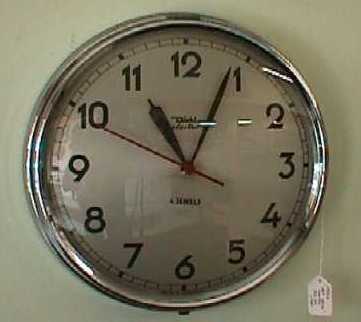

Parts:
Anchor:
The name given to the lever attached to the alarm-clock to release the escapement gear one tooth at a time.
 Alarm Lever:
Alarm Lever:
The lever used to restrict the alarm gear from unwinding.
 Balance Spring:
Balance Spring:
The hairspring and the balance
form the oscillating
system. The balance spring of an clock consists of a thin and
flat wire made of Nivarox.
 Balance Wheel:
Balance Wheel:
Part of the escapement of a mechanical clock.
Oscillating device which divides the time into equal sections.
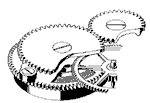 Barrel:
Barrel:
The barrel contains the wound-up mainspring, hooked to it at
its outer end which stores the energy, assuring a power reserve
of 36 to 45 hours to the clock. The mainspring is wound up manually
by means of the crown.
Bridge:
Brass plate fixed on the main plate by two or more pins and
screws. Between the bridge
and the plate the wheels and staffs are
turning.
 Crown:
Crown:
Key to wind up and set the watch to time.
Escapement Wheel:
The escapement wheel and the lever build the
escapement. It is the last wheel in the gear-train.
Escapement:
Mechanism built in between the gear train and balance
wheel. The escapement transfers the power from the gear train in
regular and even time sequences to the balance, the oscillating system.
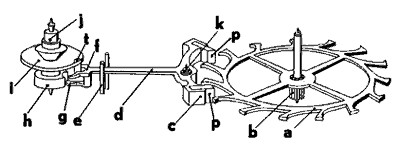
Gear Train:
The system of wheels and pinions which, from the barrel
B, transmits the driving power to the escape wheel E, Z1
centre-wheel, Z3 third wheel, Z5 fourth wheel. E escape wheel. All
these wheels are riveted to their respective pinions, Z2, Z4, Z6.
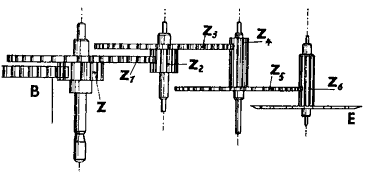
 Mainspring:
Mainspring:
Flat coiled spring that powers all mechanical watches.
 Pallet:
Pallet:
Part of the lever escapement, shaped like a ship's anchor .
NOTE: Some of these figures are taken from Oris Watch Co. Site

Working:
Removing the winding knobs and the back-case of your clock
reveals the inside of the clock.

By removing the stand, hands, face and
mounting ring, you end up with the clock mechansim itself.
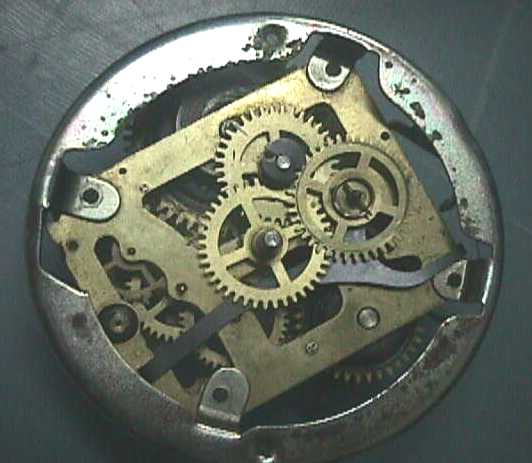
You will see
the main spring.The basic idea behind the spring is to act as an energy
storage device so that the clock can run unattended for long periods of
time. The "Potential Energy" of the spring provides the driving force
to run the clock . A similar but a smaller spring provides energy to
the alarm . These springs have clutches to restrict the back-rotation
when we are winding the main-spring using the crown.
So let's say that we wanted to use a winded main-spring to create the simplest
possible clock -- a clock that has just a second hand on it. We want the second hand on
this simple clock to work like a normal second hand on any clock, making one complete
revolution every 60 seconds. We might try to do that simply by attaching the main-spring
to a wheel and then attaching a second hand to the wheel as well. This, of course, would
not work. The main-spring would always be in tension to unwind. So in this simple
mechanism, releasing the spring would cause it to unwind and the wheel will rotate
with a very high speed until the main-spring gets totally unwind.
Now if we put some sort of restriction on the spring and allow it to open
with time---- our aim would we fulfilled.
Here an escapement mechanism comes into picture ----
|
|

|
|
| This animated GIF of the clock escapement
is actually always
going CCW, being blocked by one or the other
teeth of the pendulum in sequence. Taken from http://www.howstuffworks.com.
|
In an escapement there is a gear with teeth of
some special shape.
There is also a pallet, and attached to the pallet is the anchor
which is used to engage the teeth of the gear. The basic idea that is being demonstrated in the
figure is that, for each swing of the pallet back and forth, one tooth of the gear
is allowed to escape. For example, if the pallet is swinging toward the left and
passes through the center position , then as the pallet continues toward the left
the left-hand pin attached to the pallet will release its tooth. The gear will then
advance one-half tooth's-width forward and hit the right-hand pin.In advancing forward
and running into th pins ,the gear will make a sound ... "tick" or "tock" being the
most common.That is where the ticking sound of a clock comes from. Also, the pallet
is attached to a balance-wheel which has a balance-spring attached to its axle,
which gives it a back and forth motion.
One thing to keep in mind is that the pallet will not swing forever.
Therefore, one additional job of the escapement gear is to impart just enough energy
into the pallet to overcome friction and allow it to keep swinging. To accomplish this
task, the anchor and the teeth on the escapement gear are specially shaped. The gear's
teeth escape properly, and in addition the pallet is given a nudge in the right
direction by the anchor each time through a swing. The nudge is the boost of energy
that the pallet needs to overcome friction, so it keeps swinging.
So, let's say that we have created an escapement like this. If we gave the
escapement gear 60 teeth and attached this gear directly to the spring we discussed
above, and if we attach a second hand with it,we have made simple clock with a
second-hand.
While accurate, this clock would
have two problems that make it less-than-useful:
1. Most people typically expect a clock to have hour and minute hands as well, so
this clock would be seen as lacking in that respect.
2. You would have to wind the clock again and again after some minutes. Because
the spring will unwound in some time.Obviously nobody would like to do this.
To solve this problem a high ratio gear-train comes into use . This makes the
main-spring to unwind in 35 to 45 hours.You can see that if you let the escapement
gear itself drive another gear train with a ratio of 60:1, then you can attach the
minute hand to the last gear in that train. A final train with a ratio of 12:1
would handle the hour hand.You have a clock.
Now let us see "how
the alarm works?". Here also there is a spring which stores the energy in it.
And to restrict the unwinding of the spring , there is a alarm lever which is also
something like the anchor . This lever is controlled by another spring-lever which
is always kept pressed by the alarm-gear . The alarm gear is synchrnous with the
hour gear . Now when the clock strikes the time set in the alarm dial , the pin in
the dial falls into a groove made on the alarm gear . This causes the alarm gear to
rise ,which in turn causes spring-lever to rise and release the alarm lever and so
the spring starts unwinding. There is a gear with special teeth which meshes with
the spring gear .This gear makes the alarm lever rotate to and fro , which hits
the case and makes the alarming sound "Trrrrrrrnnnnnnnnnn".
You can see that although the gears in a clock make it look complicated,the
working is fairly simple.There are 5 basic parts:
1. The spring - this provides the energy to turn the hands of the clock.
2. The weight gear train - a high-ratio gear train,transmits the motion of the
spring, so that you don't have to rewind the clock very often.
3. The escapement - made up of the pallet, the anchor and the escapement gear,
the escapement precisely regulates the speed at which the spring's energy
is released.
4. The hand gear train - gears things down so the minute and hour hands turn
at the right rates.
5. The setting mechanism - somehow disengages, slips or ratchets the gear train
so the clock can be rewound and set.

Related Links
- How Mechanical Clocks Work
- Glossary of Parts
Pages prepared as part of the course ME371 Hands-on lab in July-Dec 1999.
Instructors:
Amitabha Mukherjee
and M.K. Muju




 Alarm Lever:
Alarm Lever: Balance Spring:
Balance Spring: Balance Wheel:
Balance Wheel: Barrel:
Barrel: Crown:
Crown:

 Mainspring:
Mainspring: Pallet:
Pallet:



